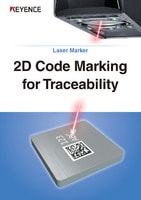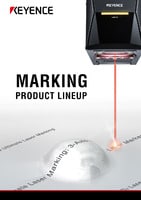Laser Marking Systems / Laser Markers
Laser Marking for 2D Codes (or More)
-
Tags:
- Laser Marking , Automotive , Electric Vehicle
While demands for smaller and thinner products and more detailed traceability continue to grow, there is an increased need for packing more information within a limited space on manufactured products.
A 2D code can hold tens to hundreds of times the information of a barcode. This high information density allows a 2D code to hold the same amount of information as a barcode in as little as 1/30 of the size. These advantageous characteristics have led to expanding applications in various fields.
Industries like the automotive industry and electronic device industry are using 2D codes frequently because of their small size and prowess as a permanent tracking/traceability solution. Learning about the different types of 2D codes, data matrices, QR codes, and barcodes is essential before application. Choosing the optimal 2D code for a product requires considering data size, product space, and later use of the code.

Laser Marking Techniques for 2D Codes
In addition to the type of laser marker, various techniques are utilised in creating 2D codes. Some of this depends on the requirements of the part or product, and some offer certain benefits over others.
From a manufacturer's perspective, there are many reasons to choose one industrial laser over another. Although that’s an important focal point, the technique is an essential part of the equation as well.
A few common techniques used for 2D codes include:
The flexibility for 2D codes has existed in manufacturing for quite some time. Of course, this hasn’t stopped new methods and technologies from emerging.
We’re here to provide you with more details.
Reach out today!

Benefits of Laser Marking 2D Codes
While there are numerous techniques for laser marking codes, it’s also important to break down the process's benefits as a whole. Efficiency is one of the more obvious ones, but the manufacturing world has a lot more to monitor than just the clock.
From the type of barcode marker to angles, such as cost-effectiveness and precision, there are many unique benefits to laser marking 2D codes.
Permanency and Durability
Results will vary depending on the technique, machine, and materials used, but laser marking 2D codes offers impressive durability. This process can be resistant to various chemicals, weather conditions, and general wear and tear.
2D barcode laser marking results became widely popular for many reasons, but its high contrast and visual clarity are a big selling point. Laser marking machines don’t all output the same results, but the modern quality of laser marking 2D codes outshines other traditional methods by a long shot.
High Precision and Quality
Aside from the longevity of the 2D code, hybrid laser markers and other designs promise high precision and consistent quality. This also equated to uniformity across every part or product, ensuring the barcode ends up in the same place every time.
Being a non-contact method of marking, lasers help mitigate the risk of distortion or damage to the material while also ensuring the most vital factor: consistency in readability.
Cost-Effectiveness and Efficiency
The cost-effective approach of using laser marking machines for 2D codes makes it difficult for manufacturers to look elsewhere. 2D barcode laser marking technology has low operating costs compared to traditional machines, and its efficiency makes it all the more worth the investment.
Mitigating consumable waste, relatively low operating and upkeep costs, and impressive versatility enhance the machines' cost-effectiveness and efficiency.
Discover more about this product.
Click here to book your demo.

Best Practices for Laser Marking Codes
Whether it’s a UV laser marker or any other type of industrial laser, there are still a handful of best practices manufacturers should know. These points may vary based on each organisation's use case and goals, but they can help streamline the laser marking process.
- Ensure machines are always calibrated
- Always have thorough quality control in place
- Consider using the Data Matrix ECC 200 format for high data density
- Keep up with ongoing cleaning and maintenance of laser markers
- Stay in line with any important regulatory requirements
- Maintain a record of historical production data to guarantee uniformity and consistent output
Although these are common best practices when it comes to laser marking 2D codes, these may look different for one business from the next. Overall, it is crucial to support the longevity of the machines while improving efficiency and quality across the board where possible.
We’re here to provide you with more details.
Reach out today!

What is the Difference Between Data Matrix/QR Code/Barcode?
Data Matrix
Developed by ID matrix in 1967, the data matrix barcode is an internationally standardised 2D code largely used because of its compact size. Data matrices come in two different configurations, square and rectangular, and contain an even number of modules. The number of modules in a data matrix barcode can be up to 144 × 144 and as small as 10 × 10 modules. Altogether, the modules can store numeric, alphanumeric, and binary data. A data matrix barcode can hold up to 3116 numeric characters, 2335 alphanumeric characters, and 1556 binary characters.
Data matrices are the most common type of code in the industrial world due to their small size and built-in error correction, which allows for accurate reading, even if some damage to the code occurs.
QR Code
Developed in 1994 by DENSO WAVE, the QR code, also known as quick response code, is a matrix 2D code made for high-speed reading. Compared to data matrix codes, the QR code can hold significantly more data. QR codes hold up to 7089 numeric characters, 4296 alphanumeric characters, 2953 binary bytes, and 1817 kanji characters. Additionally, the QR code holds up to 177 × 177 modules but no less than 21 × 21.
There are three classifications of QR codes:
- Model 1
- Model 2
- Micro QR
Model 2 contains the greatest data capacity and is modelled after Model 1. The QR code size, or type of model, is determined by multiplying the number of modules by module size. While less common in an industrial sense, QR codes are very common in consumer-facing products as they can be scanned by most smartphone cameras and can link to a company's website for re-ordering or product information.
Barcode
Created by Symbol Technologies in 1989, the PDF4117 Code, also known as a barcode, is a 2D stack code. Barcode is easier to say, but the PDF4117 name has a significant meaning. The name is broken down into two parts:
- PDF → Portable Data File
- 417 → 4 bars, 4 spaces, and 17 modules
Barcodes hold up to 1850 alphanumeric characters, 2725 numeric characters, and 1108 binary data bytes. There are four categories of barcodes, which are the following:
- Compact
- Macro
- Micro
- GSI Composite Code
Compared to QR codes and data matrix barcodes, 1D barcodes hold the least amount of data.
Discover more about this product.
Click here to book your demo.

Electronic Device Industry
Electronic devices are extremely small, but the compact size of 2D codes allows for storing all the data needed, even with compromised space. By no means are these codes limited to the electronics industry, though. Nearly all industries have begun implementing these types of markings for tracking and traceability.

An 18 × 18 cell Data Matrix with 26 numerical digits, such as GTIN and expiration date, etc. can fit into an area as small as 0.5 mm × 0.5 mm
Curious about our pricing?
Click here to find out more.

Automotive Industry
Quality control and traceability management are necessary in the automotive industry. Without it, there could be dire consequences from a defective product. 2D codes are used for manufacturing instructions or general product data, so they need to be reliable. Using 2D laser marking ensures that the laser-engraved QR code will always be accurate and easy to read.
We’re here to provide you with more details.
Reach out today!






